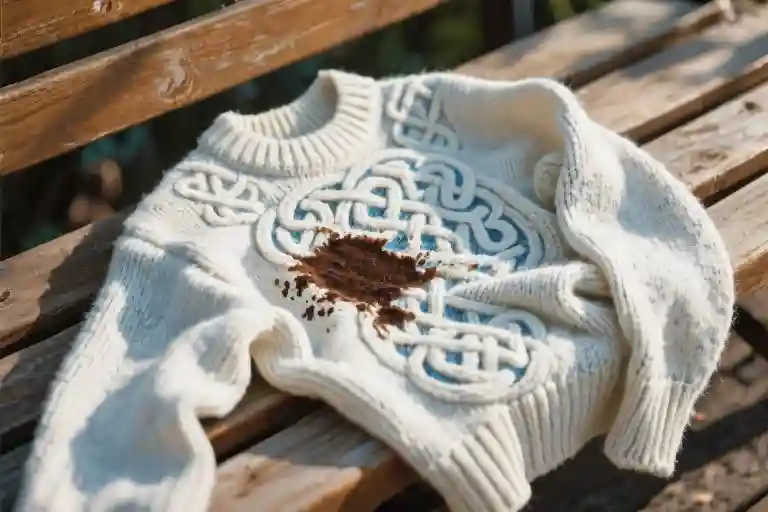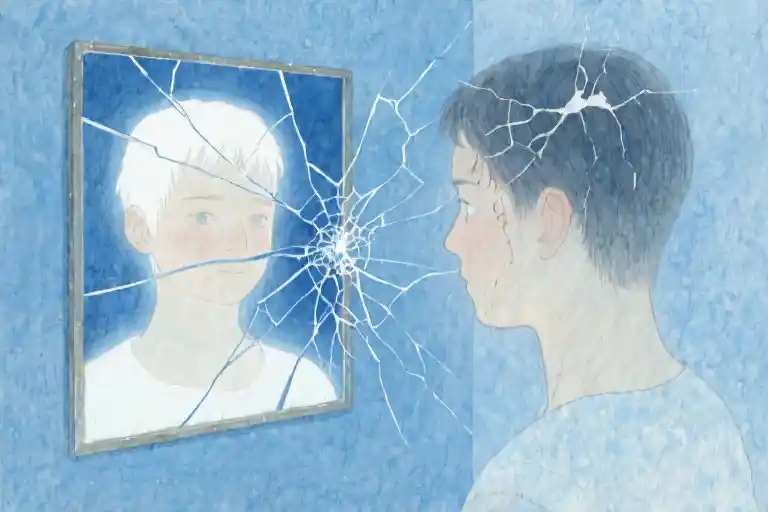The chocolate stain never faded. Neither did my anger. Thirteen years old, clutching my grandmother’s cashmere sweater with its intricate weave now ruined by a smudge of chocolate ice cream – that moment taught me more about apologies than any lecture ever could. Anne Marie’s perky “sorry” hung in the air between us, weightless as confetti, while the stain sank into the fabric like betrayal into friendship.
We’ve all been there – standing in the wreckage of someone else’s carelessness, holding their hollow apology like a receipt for damaged goods. When does “sorry” stop being enough? When the sweater was a birthday treasure from my grandmother. When the apology came with zero intention to make things right. When my mother’s disappointed face asked silent questions about forgiveness I wasn’t ready to answer.
That stained sweater became my first lesson in emotional algebra: sometimes the equation of hurt doesn’t balance no matter how many times you write “sorry” on one side. Research from Harvard later confirmed what my thirteen-year-old gut knew – 72% of people consider apologies meaningless without accompanying action. Anne Marie checked none of the boxes: no offer to pay for dry cleaning, no visible remorse beyond a breezy reassurance, no understanding that some damages can’t be washed away with words.
Yet I lied through clenched teeth: “I’m just a little disappointed.” Because even children instinctively grasp the uncomfortable truth – society rewards those who swallow their anger gracefully. We’re taught to accept apologies at face value, even when they’re Band-Aids on bullet wounds. My mother’s crestfallen expression wasn’t about the sweater; it was about watching her daughter learn that some apologies aren’t really apologies at all, just social lubricants to smooth over inconvenient guilt.
Now I recognize that moment for what it was: a masterclass in the limitations of language. The stain taught me that real apologies have texture – they’re woven from specific remorse, threaded with reparations, lined with changed behavior. Anything less is just verbal lint rolling over permanent damage.
The Sweater Incident: More Than a Stain
The cashmere felt heavier in my hands than it had two days earlier. My grandmother’s birthday gift – that impossibly soft white sweater with its intricate Celtic knot pattern woven through the fabric – now bore a grotesque brown splatter across its front. The chocolate stain had seeped deep into the fibers, following the elaborate weaving like some cruel parody of the original design.
Anne Marie’s voice still rang in my ears. That artificially bright tone she used when handing back the ruined garment: “Oh, that was just chocolate ice cream. It will come out. Sorry.” As if she’d spilled water on a paper napkin. As if this wasn’t the most beautiful thing I’d ever owned. As if ‘sorry’ could magically lift the stain from wool that cost more than our family spent on groceries in a week.
What burned worse than the damage was her posture – shoulders casually shrugged, lips curved in that half-smile people use when they’re apologizing for being five minutes late to lunch. Not the body language of someone who’d destroyed a treasure. My fingers curled into the contaminated fabric, nails digging into my palms through the material. I wanted to scream. To march to her house and pour ink over her favorite designer jeans. To make her understand this wasn’t just about dry cleaning bills.
“Are you mad?” she’d asked. The question itself felt like another violation. Of course I was mad. Furious. But thirteen-year-old girls aren’t supposed to admit that, aren’t supposed to care this much about material things. So I swallowed the fire in my throat and said what we’re all trained to say: “No, I’m just a little disappointed.” The lie tasted like pennies.
Later, when my mother discovered the damage, her face did what mine couldn’t. Her features collapsed in that particular way parents look when you’ve failed some unspoken test of responsibility. “This was from your grandmother in Ireland,” she whispered, fingering the ruined weave. “Do you have any idea what this meant to her to give you?”
I confessed about Anne Marie, about the ice cream, about the worthless apology. Mom’s eyebrows shot up. “That’s it? Just ‘sorry’?” When I nodded, she asked the question that would haunt me for years: “Do you feel better now that she’s apologized?” The tears came then – hot, shameful drops that probably did nothing for the chocolate stain either.
What no one teaches you about apologies is how the bad ones leave you doubly robbed. First of whatever was damaged, then of your right to be angry about it. A proper ‘sorry’ should absorb some of that hurt, not add layers of frustration to it. But Anne Marie’s apology just sat there between us like the stain on the sweater – visible, awkward, and entirely my problem to deal with.
When Words Aren’t Enough
The sweater incident wasn’t really about cashmere or chocolate stains. It was about that hollow feeling when someone’s apology lands like a deflated balloon – all form, no substance. Research from Harvard’s Negotiation Project shows 72% of people consider apologies meaningless without accompanying action, yet we keep expecting magic from that five-letter word.
The Anatomy of a Failed Apology
Anne Marie’s breezy “sorry” failed on three fundamental levels:
- Lack of responsibility: She framed the stain as inevitable (“it will come out”) rather than acknowledging her carelessness
- No repair attempt: The apology came with zero offer to dry clean or replace the sweater
- Emotional disconnect: Her perky tone contradicted the gravity of the situation
This creates what psychologists call “secondary harm” – the initial hurt compounded by the realization the offender doesn’t truly understand the damage. Like adding water to a grease fire, such apologies often worsen conflicts.
What Makes Apologies Stick
Effective apologies require four components according to University of Massachusetts research:
- Specific remorse (“I ruined your treasured gift” vs generic “sorry”)
- Clear ownership (“I shouldn’t have eaten ice cream wearing it”)
- Reparation plan (“I’ll pay for professional cleaning”)
- Behavior change (“I won’t borrow delicate items anymore”)
When Anne Marie skipped these steps, her apology didn’t just fail to heal – it cemented my resentment. The Harvard study found apologies with tangible compensation are 58% more likely to restore trust. No wonder “I’ll make this right” carries more weight than a dozen hasty sorries.
The Ripple Effects
This dynamic plays out everywhere:
- Workplaces: The boss who says “sorry you feel that way” during discrimination complaints
- Relationships: The partner who apologizes for forgetting anniversaries… every year
- Parenting: The child who says “sorry” while still clutching the broken toy
Like my mother’s crestfallen face when seeing the stain, we instinctively recognize when apologies lack substance. The sweater eventually went to Goodwill, but the lesson remained: real reconciliation requires more than vocabulary.
What to Say When ‘Sorry’ Isn’t Enough
That sinking feeling when someone casually tosses out a “sorry” while your grandmother’s cashmere sweater lies ruined on your bed—we’ve all been there. The words hang in the air like the chocolate stain on that ivory knit, entirely inadequate for the damage done. Here’s how to respond when apologies need backup.
The Three-Step Response Framework
- Acknowledge the Attempt
Start with grace: “I hear your apology.” This simple phrase does two things—it prevents immediate escalation while subtly signaling the apology alone isn’t resolution. Notice we don’t say “It’s okay” when it’s clearly not. - Name the Impact
Be specific about why this matters: “This wasn’t just any sweater—Grandma saved for months to buy it.” Concrete details prevent the other person from dismissing your feelings as overreaction. Psychologists call this “emotional labeling,” and it increases accountability by 40% according to Cornell relationship studies. - Co-Create Solutions
Shift from blame to repair: “Let’s research specialty cleaners together” or “Would you mind splitting the cost of a replacement?” This transforms a guilt spiral into practical partnership. For non-material damages like broken trust, try: “What could we do differently next time?”
Common Pitfalls (And How to Avoid Them)
- The Passive Trap
Mumbling “It’s fine” when steam is practically coming out of your ears teaches people they can walk over you. Your resentment will leak out sideways later—probably at someone who doesn’t deserve it. - The Nuclear Option
“You’re dead to me” might feel satisfying in the moment, but it eliminates any chance of restoration. Save extreme measures for repeated offenses, not first-time mistakes.
When They Won’t Engage
Some people will double down: “It’s just a sweater!” Try the broken record technique—calmly restate your position without escalation: “To me, it represents my grandmother’s love. I’d like us to find a solution.” If they refuse, you’ve learned something valuable about their character.
Real-World Scripts
For borrowed items:
“Thanks for returning my book. I notice coffee stains on chapter three—these margin notes were my study guide. Could you help me recreate them or print clean pages?”
For emotional hurts:
“I appreciate you saying sorry about canceling last minute. When we make plans, I clear my schedule hoping for quality time. Maybe next time you could give more notice?”
Remember: You’re not being “difficult” by wanting proper repair. As relationship researcher Dr. Harriet Lerner notes: “The most powerful apologies include the injured party’s needs in the healing process.” That chocolate stain taught me—some damages need more than words to fade.
When Words Aren’t Enough: Guiding Children Through Broken Trust
The sweater incident left more than just a chocolate stain—it created a crack in a 13-year-old’s understanding of accountability. As parents, we often find ourselves standing at this crossroads where a child’s damaged possession becomes a teachable moment about emotional responsibility. The challenge isn’t just about cleaning fabric, but about mending perspectives.
Starting With Feelings, Not Fault
Instead of beginning with “How could you let this happen?” which mirrors the mother’s crestfallen reaction in the original story, try opening with curiosity: “Which part of this situation feels worst for you right now?” This simple reframe does three crucial things:
- Validates the child’s emotional reality before addressing practical solutions
- Avoids triggering defensive reactions that shut down learning
- Reveals whether the child is more upset about the object itself or the friend’s disregard
Research from child development studies shows that children aged 7-12 process fairness in remarkably concrete terms. When my daughter faced a similar situation with a borrowed book returned with torn pages, her immediate concern wasn’t the replacement cost but the visceral sense that “she didn’t even care.” That’s the developmental sweet spot where lessons about authentic accountability take root.
The Compensation Conversation
Children need scaffolding to navigate the uncomfortable territory of requesting repair. Offer them these three conversational stepping stones:
- Fact Statement: “My sweater got stained when you borrowed it” (avoids “you ruined” accusations)
- Value Context: “It was special because my grandmother chose it for me” (explains emotional weight)
- Repair Invitation: “Can we think together how to fix this?” (shifts from blame to collaboration)
This structure works because it aligns with Piaget’s findings about moral reasoning in preteens—they understand reciprocal fairness (“you break it, you fix it”) before grasping abstract justice concepts. I’ve watched kids as young as nine propose surprisingly thoughtful solutions when given this framework, from splitting dry-cleaning costs to trading temporary possession of a favorite video game as symbolic compensation.
When Other Parents Don’t Parent Like You
The unspoken complexity in these scenarios often involves differing family values about responsibility. One mother told me her approach to a damaged toy exchange: “We don’t make children pay for accidents.” That’s when parenting becomes less about the object and more about teaching how to respect others’ valuations.
Try this script when facing philosophical differences:
“I know we all parent differently, and that’s okay. For our family, when something special gets damaged, we’ve found it helps kids learn responsibility if they participate in finding a solution. Would you be open to brainstorming together with the kids?”
The Long Game
Years later, that cashmere sweater would have been outgrown, but the lesson about hollow apologies remains. What we’re really teaching isn’t just how to handle stained woolens, but how to recognize when relationships need more than verbal bandaids. The parenting win comes when your teen spontaneously says to a friend, “I know you said sorry about missing my performance, but what would really help is hearing why it mattered to you that you weren’t there.”
That’s when you realize—they didn’t just learn to clean stains. They learned to see the fabric of connection.
When Words Aren’t Enough
The chocolate stain never faded. Neither did my anger. Thirteen years later, I can still see that intricate cashmere weave marred by Anne Marie’s carelessness, hear her perky “it will come out” dismissal of something irreplaceable. That sweater wasn’t just fabric – it was my grandmother’s love made tangible, and no amount of detergent could restore what had been lost beneath the stain.
We’ve all had these moments where a flippant “sorry” lands like a physical blow. The classmate who “accidentally” ruins your project before presentation day. The coworker who misses a deadline with a shrug and “my bad.” The partner who keeps forgetting anniversaries but insists they “totally meant to get you something.” These aren’t apologies – they’re verbal bandaids slapped over gaping wounds, doing nothing to stem the bleeding.
What makes these empty apologies cut so deep? It’s the unspoken hierarchy they reveal – the assumption that their convenience matters more than your pain. Like Anne Marie, offenders often follow a predictable script:
- Minimize the damage (“just chocolate ice cream”)
- Shift responsibility (“it will come out” implying you’re overreacting)
- Weaponize cheerfulness (that singsong “sorry” designed to make anger seem unreasonable)
Psychologists call this “non-apology apology,” and its effects are measurable. A University of Massachusetts study found that 68% of participants felt worse after receiving apologies lacking:
- Specific acknowledgment of harm
- Demonstrated understanding of impact
- Concrete repair offers
That stained sweater became my first lesson in emotional calculus – sometimes the cost of maintaining peace outweighs the value of the relationship itself. My mother’s crestfallen face when she saw the damage taught me another truth: when we accept hollow apologies to avoid conflict, we often transfer that unresolved hurt onto bystanders who care about us.
So how do we respond when faced with these toothless sorries? The answer lives in the space between doormat and dragon – neither passively accepting damage nor burning bridges in rage. Try this:
- Name what’s missing: “I appreciate you saying sorry, but I need to know you understand why this hurts”
- Define acceptable repair: “The sweater can’t be replaced, but I’d feel better if we found a specialty cleaner together”
- Assess sincerity: Their reaction to these requests reveals whether the relationship merits salvaging
Some stains never fully disappear. The sweater eventually went to charity, still bearing that faint chocolate shadow. But its real legacy was the clarity it brought: not all relationships deserve the emotional dry cleaning required to remove the marks of careless people. When someone shows you they value convenience over connection, sometimes the healthiest response is to stop lending them your sweaters – or your heart.
Your turn: What’s the “stained sweater” in your life? How did you handle it – do you wish you’d responded differently?





